By Emily Riippa | University Archives and Copper Country Historical Collections
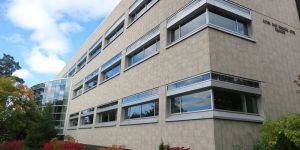
Classes are back in full swing at Michigan Tech, and that means that students are hitting the books. Huskies can be spotted deep in concentration around lab equipment, state-of-the-art computers, well-decorated whiteboards, and, of course, library tables. Drive past the Van Pelt and Opie Library late at night, or walk through the first floor reading room in the afternoon, and you’ll find students meeting with friends and powering through problem sets with help from classmates. In recognition of the importance of the library to Tech students, the building closes completely only once a year, the night of Winter Carnival’s all-night snow statue competition. Though the library and its resources have been powering Huskies for decades, the space dedicated to the library and what it provides have seen significant changes. Let’s journey back into the Michigan Tech Archives to see the life of the library over more than a century.
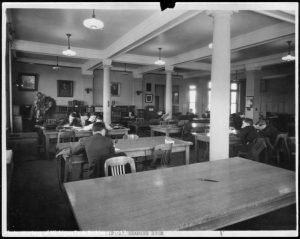
The library of the Michigan Mining School began with a gift of 3,000 bound volumes coordinated by J. Sturgis, a member of the Houghton County Historical Society; materials owned by the school’s faculty apparently supplemented these holdings. As enrollment grew and the Michigan Mining School became a college, the library blossomed. In 1912, to help students and professors alike make best use of the burgeoning collection, the Michigan College of Mines helpfully produced a “Handbook of the Library” to inform students about available materials, special features, and etiquette for this hallowed ground. By this point, the college’s books and other publications resided in a “fire-proof structure” that also housed the MCM geological and mineralogical collection. College business and executive offices shared the space, as well. As the Academic Office Building, the old library continues to host office spaces for various departments to this day.
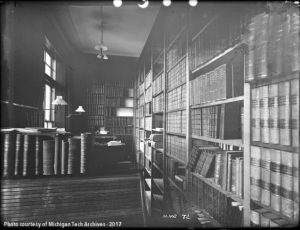
Those visiting the library were advised that the now “26,000 volumes, 14,000 pamphlets, and 1,450 maps” were “largely scientific and technical in character,” befitting the college’s curriculum. Future mining engineers could find “complete sets of all the important mining and engineering publications,” as well as “journals of scientific lines allied to mining engineering.” So patrons would be able to successfully navigate the two-winged brick building, the handbook included a useful sketch of the floorplan, showing the locations of books, newspapers, minerals, and the “modern equipment” of which library staff were proud. To clarify the availability of materials, the handbook explained that, while “the Library is intended for free reference use[,] the privilege of borrowing books for home use is accorded to all officers of instruction and to all registered students. This privilege is extended to all responsible persons who apply to the librarian for it.” Now, faculty and students are joined by all Michigan Tech staff members in enjoying the ability to check out books, and community members may also apply for courtesy cards allowing them the same opportunity.
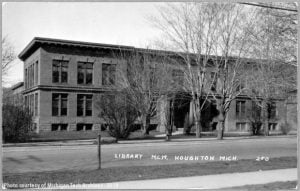
A growing library with a diverse collection needed able workers to sustain it. In 1940, the Daily Mining Gazette published a profile of the Michigan College of Mining and Technology that explored its staff and the special collections in their charge. Librarian Madeleine Gibson, an alumna of Wellesley College and the University of Wisconsin who remained at Tech for 35 years, led the trio. Under her worked two library assistants, Florence McGee (who also served as a cataloger) and Lillian Combellack. The three women oversaw holdings that had grown to 39,000 “books and bound serials, and a collection of pamphlets on scientific and engineering subjects.” Gibson, McGee, and Combellack also cared for a depository of documents produced by the federal government and the Michigan state government. The Gazette noted that a special display case had been designated as housing for the “John M. Longyear Spitzbergen collection, consisting of books, magazine articles and pamphlets on Spitzbergen.” The eponymous Longyear, a lumber baron and former member of the university’s Board of Control, had established a coal mining company on the remote Norwegian island territory of Spitzbergen (also known as Spitsbergen), and materials pertaining to the company logically found a home at the MCMT. Students whose interests bent more to music than Norwegian mining could check out a set of musical books “donated by the Carnegie corporation of New York City.” Patrons could peruse the shelves during the extensive reading room hours held six days a week.
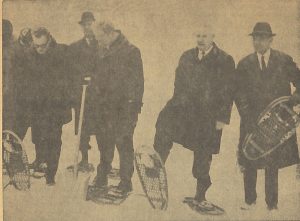
By the 1962-1963 academic year, the library building was bursting at the seams. Campus boasted over 2,700 students in more than twenty fields of study, and the library, built to accommodate a much smaller collection and student body, now housed 78,000 volumes. Governor George Romney requested $750,000 in planning funds for a new library from the state legislature, a decision that Tech president J.R. Van Pelt credited with expediting the construction by two years. Herman Gundlach, Inc., submitted the successful bid for the general contract, and work began shortly thereafter, with a “snowbreaking” held on February 11, 1965. The building, situated just east of the Memorial Union Building on College Avenue, totaled 80,000 square feet over four stories, offered space for 225,000 volumes, and seated 1,000 students. According to a December 1964 press release, each of these figures represented a six-fold increase of the prior capacity. The design of the library also emphasized “flexibility provided by a modular plan of construction,” simultaneously reducing the number of interior walls, and created private study areas “around the periphery of the stacks.” Graduate students and faculty enjoyed designated study spaces, and new homes were made for the Michigan Tech Archives, microforms, and typing stations. In a move that might seem confusing to modern eyes, the design prominently incorporated a smoking room for patrons. On October 29, 1966, dignitaries gathered at a large dedication ceremony for the completed new facility, which architect Ralph Calder characterized as “the most inspiring” of campus buildings “because it is the intellectual focus on campus.” The library subsequently received the name of J.R. Van Pelt, in honor of the president who led Tech during its construction.
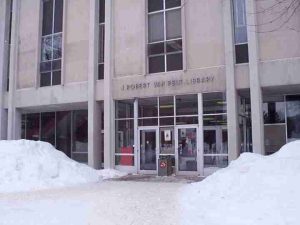
Time marched on, and campus growth and development once again compelled changes to the library building. When the North Central Association made a university accreditation visit in the 1997-1998 school year, reviewers suggested that Tech “plan to increase the size and scope of library resources” and find funding for future improvements of the library physical plant. A proposal in 2000 to create a Center for Integrated Learning and Information Technology (CILIT), which would help to provide some of the improvements and connect the library to Fisher Hall, met with some resistance from staff writers at the Lode, and the building, as proposed, never came to fruition. Instead, the suggested CILIT structure became Rekhi Hall. Meanwhile, a $5 million donation from John Opie (class of 1961) and his wife Ruanne funded the most extensive renovation and expansion of the library since the mid-1960s construction. The Opie Library expansion to the Van Pelt Library, dedicated in April 2005, created a soaring new reading room with a prominent glass front, two dozen study rooms for team projects and collaboration, and “the latest technologies, including an information wall” to provide “the latest on library and campus activities, as well as a steady stream of news and weather.” In the 54,000 square feet of additional space, students also had access to a large number of public computers. Meanwhile, visitors to the garden level would find the archives had been moved from their place on the second floor to a new, purpose-built facility that expanded reading room seating and provided secure, climate-controlled storage for irreplaceable historical records.
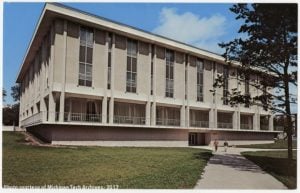
The building may be different, from its style to its location; the collection may have grown from 3,000 to several hundred thousand volumes; the smoking room may, thankfully, have given way to computer labs and cafes. Despite the changes over the years, it’s undeniable that the library has always been and remains a cornerstone of Michigan Tech.
What memories of the library stand out for you?
I was at Tech 1968-1972. I remember music listening booths in the basement. They were tiny sound proof cubicles where we’d play the LP’s the library had available. Back then you needed a turntable and there was one in every booth. We’d crank the volume up and enjoy our favorites. That way you didn’t have to worry about another dorm resident complaining about your loud stereo.
What ever happened to the giant 3D globe that was in the main lobby?
I was at Tech ’72-’74 and ’79-’81.
The music listening booths in the basement were awesome!
Spinning the vinyl, counting the holes on the acoustical tiles on the ceiling
(others had done it before us; left their counts for others to confirm).
The carillon was in full swing back then.
The A.E Seaman Collection was on display as well.
The folks behind the counter were amazing!
Such an untapped wealth of information and research help, right there.
Ruanne Opie, wife of GE’s John Opie, whose name is on the library, did my laundry for me and other students in 1959 to earn extra money to get them through Tech. She insisted on ironing everything overlooking my objections that is wasn’t necessary. I suspect that this couple were quality control experts even in college.
When I started at the ‘da Tech’ in 1965 we were still using the old library behind what was then the Administration building. I remember the floors made of glass-blocks and the ‘bridge’ from the Admin building. The new library was under construction and we got to use it in the Fall of 1966. The two things that I remember the most about the new library was the enormous globe in the main part of the library and the carillon that entertained us each day at noon. Another amazing feature was the new map room. This was long before the days of Google Earth and we were impressed by the map collections and their level of detail.
I was at Tech from 1957-63. Class of 61 note Hotel Scott below
I worked in the library for a couple of years 59-60 when M.V. Krenitsky was the Director. My job was to go through the stacks and gather loose periodicals into their yearly order to then send off to the bindery to be bound into books. I was surprised that many of them were in Russian and German. When they came back from the bindery I put them up on the shelves. The job paid $1/hour which was quite good for the time. I also tended bar at the Scott for $1/hour. Needless to say there was no college debt to worry about after graduation.
The library was next to the ROTC building as I remember with a quite small reading area but a large collection of books and reference material. The periodical stacks may have been off limits to casual browsing as I was usually the only person there.
I had occasion to visit the Van Pelt/Opie library in 1998 (50 year birthday of Delta Sigma Phi) and there were the bound volumes I had looked over. They were buried deep in the stacks but they were there.
Thanks for the comments. They reminded me about the huge globe, which frankly I forgot about. And it was huge. Where did that go? And I do remember the music listening booths. I also remember browsing the magazine racks on what I remember was the second or third floor and finding architectural magazines where I read about the great Chicago Plan after the Chicago fire. But what I most remember is the Charles Eames lounging chairs in the reading area where the coffee shop is now. Spent many hours reading the Chicago Tribune and following the Chicago Blackhawks and Tony Esposito on those Charles Eames chairs.
Tom Permoda BSCE 1973.
In the summer of 1967, the first summer the library was in use, and before I became a ME student at MTU in 1968, I was sent to the library to start the central air conditioning machinery. I was 25 yrs. old then. My employer, the Trane Co., sent me that summer to do a start-up, under full load conditions, of the steam-fired 275-ton absorption cooling machine. The idea was to test the capacity of the machine operating under a full cooling load. Well, that June, in Houghton, the ambient temperatures were well below 80 deg. So, to test the machine, I imposed a load by forcing all the building’s steam heating coils to full steam. The test was going along very well until a campus steam plant engineer came running up the stairs to the penthouse mechanical room, and asked me “What the hell are you doing?!?! As he explained, I was using up all the steam the central steam plant could produce, and the result was that they did not have enough steam to operate the laundry, or the main cafeteria. As a young technician, I called my boss and was told by him to do the best I could. I believe the machine was way over designed and needed to run at only half capacity, which was before global warming.
Ken Sikora, Green Bay, Wisc.
Class of Dec. 1970
Does the carillon still exist, atop the Library? If so, does it still play the Alma Mater at 8 p.m. every day? I would love to hear it again.
Might the “snow-breaking” have been in 1964? I graduated at the end of fall term in ’64 and I think I remember the skeleton of the new library already standing at that time. One could walk planks across a “moat” to get into the future new building.
Professor Larry Rakestraw, a history prof., had hired me to make a map of his research on Isle Royale. He was looking for features noted by the GLO surveyors in the 19th Century. My map hung in Fisher Hall that fall — at least I think it was Fisher Hall. And it seems that there was a pretty good start on the new library at that time.
I started at Tech in 2012 and I believe that was the last year they had the information wall across from the front desk. Watching TV there with a coffee from the cafe was my favorite pass time between classes. The following year, I started working at the Library and worked up until my graduation in ’17. I had a great time working with the staff there. They do so much more than anyone really knows. Shout out to Mary Mongeau, Linnea McGowan Hobmeier, Elisabeth Dennis, Erin Matas, David Zei and many others for making my time there special.
I remember the installation of he globe and spent a little time marveling at it with each visit to the building. I should have gone more often as those additional visits may have prevented my academic probation.
I used the library often as a quiet study place. But a unique feature was the archive maps and plans of the old copper mines in the Keewenaw. My friend and I went looking for one such mine. It was off the beaten path and it took us half a day to locate the actual site (we walked right past it twice!). It was obvious that it had not been touched in ~70 years. Although strictly forbidden by school rules, we went down into the shaft and by the time we got 100 feet down, EVERYTHING was intact – just as the miners had left it when the mine closed down. Shovels, picks, trolleys, tracks, buckets, lamps, canteens, food tins, etc. What a time-warp – as if they could come back from lunch at any minute! When I visited campus a few years ago, I had to see if the library archives still contained these fantastic treasure maps – YES, they are still there!!!
The Globe was likely donated by the Abrams Aerial Survey Foundation. Talbert Abrams (1895 – 1990) was the pioneer of photogrammetry – the science of making reliable measurements in surveying and map-making, usually from aerial photography.
Many fond memories of late-nite study in the stacks among shelves of US patents! Also played carillon in sophomore thru senior years … John Clark, then Director of Glee Club & University Choir, said he had too many extra jobs: would I like to play carillon? Of course!! Reported to Riley Whearty (sp?) and Richard Dunnebacke (sp?), and was paid very well. Three 45-minute recitals per week (Tue, Thu, Sat, 5-5.40pm) then a dash to the cafeteria!! Music ranged from Renaissance & Baroque through Romantic, to show tunes and occasional (carefully disguised) rock themes, plus requests from walk-ins. Many nice comments from students & local folk. What fun!!
Does the carillon still exist? Klann console in the NE corner of the first floor controlled a Schumerlich electro-mechanical bell-sound production device (metal bars struck by solenoid-driven hammers, then guitar-like pickups fed vacuum-tube amplifiers that drove roof-mounted speaker horns) – da works were in the basement. In absentia mea, the roll player sounded out tunes, and a timer-driven mechanism rang the hour. Cool gadget, for early ’70s!